Credits: Biovision-Infonet
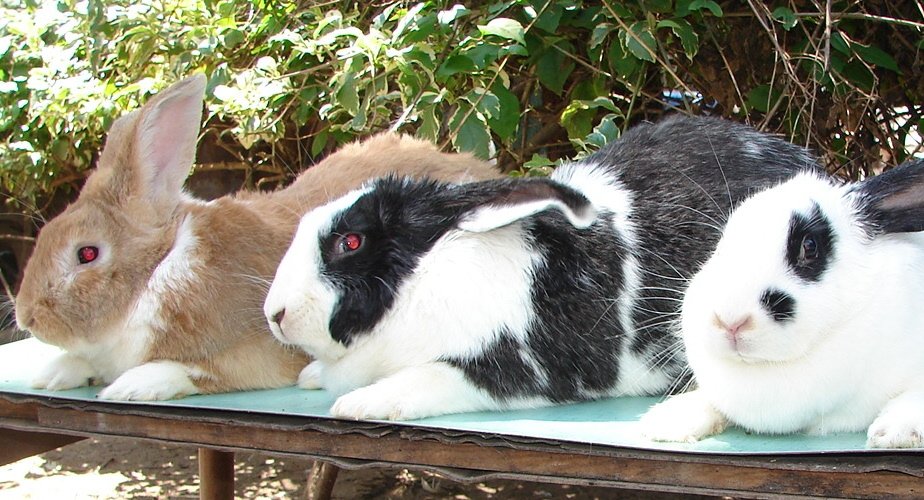
(c) A. Bruntse, Biovision
Good health in the rabbits comes from keeping the environment clean, dry and well-ventilated and avoiding overcrowding.
Understand rabbits as the animals they are
The big eyes situated at the sides of the head clearly indicate that rabbits are hunted animals, and many big and smaller predators want rabbit meat.
Rabbits are alert, awake or sleeping, and have very good senses, in particular hearing and smelling, but they can see both 360o around them and in the air, but their eyes are very poor in bright sunlight. Therefore, they forage in early mornings and in twilight. If living in safer conditions they graze several hours every day. They can often sense vibrations in the ground from other animals running or walking. They have a peculiar flight behavior running in straight line and then abruptly changing direction, to shake off the pursuer. When they sense danger, they stomp their muscular hind legs in the ground to warn their fellow rabbits.
They give birth to 4-12 kittens, which are well hidden in a nest the first 8-10 days of their lives, blind and naked at birth, and only need feed morning and evening. They can have several litters during a one-year period. Rabbits are pure herbivores and born to live on the ground; they forage and hide on the ground, and do not like to be lifted, but they like to climb up on small hills or somewhere where they can get a better overview. They are curious animals, even though they have to be alert and are easily scared. Most rabbit breeds live underground in holes and others in nests on the ground.
They are social animals, living in colonies or groups. They have been introduced to some environments where they did not live naturally, and have caused major problems because they did not have predators there and therefore spread all over the area, e.g. in Australia. Some rabbit breeds are quite sensitive to heat and do not tolerate temperatures more than 35oC.
Rabbit production with growing potential
Rabbit production is one of the livestock enterprises with the greatest potential and room for expansion in Kenya. This is because of their minimal investment requirements and ability to reproduce fast. Their feed requirement is low, especially with regard to demand for grain. Their housing and disease control management requirements are also low. Yet their meat is highly nutritious and healthier source of protein when compared with other sources of meat. Second to ostrich, rabbit meat is the highest protein meat available. It is fat and cholesterol free, so is not only highly nutritious but also very easily digested. It is, therefore, much better value than chicken. The potential for rabbit production is high, considering that other sources of meat are often scarce and out of the financial reach of most families.
Rabbit production has experienced a steady growth in the past few years, with gender biases associated with its production fading away. This is a significant change considering that for many years, rabbit production in Kenya was confined to the youth, mainly 4-K club members and young farmers. Though rabbit meat marketing is yet to gain ground, there is hope that with the growing awareness of the benefits of rabbit meat, it will be possible for rabbit meat to be introduced into the regular meat market.
The realization that rabbits are well suited to rapid production of protein has increased the number of industrialized production units just like in poultry. The most popular breeds used in the meat industry are the New Zealand White, Californian, Flemish Giant, French Ear lop, Chinchilla and Dutch. Other breeds include the Angora primarily kept for fur and as pets; most of the locally available breeds are cross breeds.
Exotic breeding stock is not readily available, although for the small farmer, there is nothing wrong with local stock because they can stand the local conditions usually more easy than exotic breeds. Marketing is still a big hurdle for the small farmer and, before venturing into the business, prospective farmers should research the market before they start. As the market grows, better stock will inevitably become available and more efforts can be made to improve management (including feeding). There is a shortage of facilities that will accept pelts for tanning in East Africa which is a shame, as the rabbit pelts are a much sought after commodity in the fashion and fabric industries around the world.
Breeds and Breeding
It is interesting to note that East Africa does not have wild rabbits. The brown creatures that are seen, mostly at night, on the plains are hares, not rabbits. The rabbits used for meat production are pure breeds of crosses of:
- New Zealand White: has a good growth characteristic, capable of attaining slaughter weight of 3 kg live weight within 12-14 weeks depending on feeding regime. It is one of the best commercial breeds that grows to a weight of about 5 kg and has all-white colour making its fur marketable. It is considered a dam breed because of its excellent mothering instinct.
- Californian White: it is bred to have broad shoulders and meaty back and hips and hence has a good meat breed with good dressing percentage. It is shorter and stockier and is white except for its ears, nose, feet and tail which are either dark grey or black. It is an ideal sire breed for interbreeding with other rabbit breeds for purposes of meat production.
- Flemish giant: this is one of the largest rabbit breeds, weighing up to 7 kg live weight. Though Kenyan farmers like it because of its size, this breed is not an ideal meat breed because of its high bone to meat ratio and its slow growth. Interbreeding it with other breeds may help improve its characteristics
- French Ear-lopped (sometimes referred to as Belgian Flop): The Lop family shares the distinction of being one of the oldest fancy breeds. The ear length, shape and size of the rabbit are a major attraction with farmers. It is favoured for meat production because of its body weight.
- Dutch: fairly small but compact rabbit with shorter forelegs. It often has characteristic markings.
- Kenya White and crosses from them
- Chinchilla: The Chinchilla is kept almost exclusively as a pet or for fur, which we do not support.
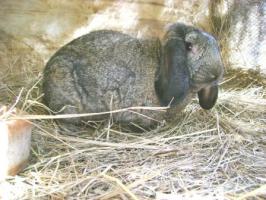
(c) Valerie Corr, Naivasha, Kenya

(c) Valerie Corr, Naivasha, Kenya
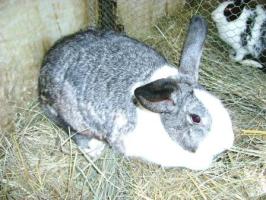
(c) Valerie Corr, Naivasha, Kenya
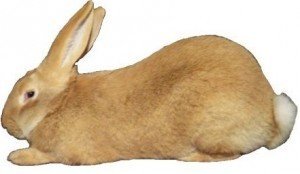
(c) Nafis
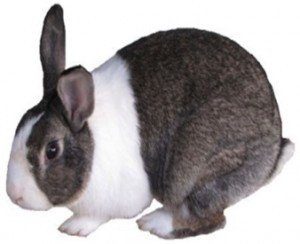
(c) Nafis

(c) Nafis
Breeding from selection of animals, to weaning of the young rabbits
In rabbits, males are referred to as ‘Bucks’ and a females as ‘Does’ and their young are referred to as ‘kits; ‘kit’ is an abbreviation of ‘kitten’. It is important that you plan your breeding, otherwise you could end up with more weanlings than you can cope with. It is very easy to get over crowded very quickly as rabbits are very prolific breeders. Plan how many weanlings you want to have in a year and how many does you need to reach that goal. One doe can have 4 – 5 nests per year with each time up to 8 kits. When they all stay alive one doe is able to provide you with up to 40 weanlings per year.
It is advisable to keep a breeding sheet on the door of each doe pen. You should record the number of the doe, the date of birth, date of service, the buck used, the date of kindling (giving birth), number of kits reared, any deaths, as well as dates of deworming (You could include a column for ‘comments’ on the far right of the sheet – i.e., whether the doe adopted another’s young or, indeed, had so many kits that she had to foster some of them).
Example of headings on breeding sheet:
It is suggested that these should be posted on the door of every breeding doe, protected by a plastic bag and stapled where the rabbit cannot destroy it. Every breeding doe and buck should have a name and number, which would be at the top of the sheet. If these sheets are kept up to date it is very easy to keep track of your breeding program.
| Doe number: 5 (Marie) | Date of birth (May 2013) | ||||
| Date | Buck number (Name) | Kindling | Number of kits born | Number of kits weaned | Notes |
| 11 May 2015 | 12 (Charles) | together for 10 minutes | |||
| 11 June 2012 | ok | 7 | + 1 still born | ||
| 15 August 2015 | 6 | 1 lost after 3 weeks | |||
| 1 September 2015 | 12 (Charles) | 15 minutes together, no mating | |||
| 2 September 2015 | 12 (Charles) | together for 10 minutes | |||
Temperature regulation in grown-up and newborn rabbits
Rabbits are very adaptable animals and are able to deal with changes in temperature because they have an inbuilt
mechanism for controlling temperature fluctuations. In cold climates
the rabbits will curl up to keep warm and in hot weather they will
stretch out (with the back legs stretched out behind them) so that they
can lose as much heat as possible by radiation and convection.
At the
same time their ear temperature will increase for cooling the blood.
The ideal temperature is from 10degC – 26degC. They are able to survive
in temperatures as low as 0degC and as high as 33degC but their
efficiency will be compromised at these temperatures.
Heat
regulation of newborn rabbits is, however, different. Kids are born
blind, naked and helpless; and it is interesting to note that they are
born with teeth. To keep warm they huddle together in a nest made by the
mother with fur from her chest. If the temperature rises, the kits will
move apart. A sudden drop in temperature can disable their temperature
control before they can huddle together again, and a kit can die of cold
10 cm away from the group. The breeder must be watchful for such
instances.
Rabbits are sensitive to humidity below 55%. They feel
comfortable if the humidity level ranges from 60 – 70%. The problem
arises during the rainy season when temperatures and humity
fluctuate. Air which is too hot and dry is even more dangerous. This is
why it is so important to have sufficient ventilation without draughts.
Gestation Period: On the average 30 – 32 days and the rabbits born on any day between the 28th and 34th
day after mating, usually survive. The duration of gestation is also
affected by the time of year, the size of the doe and, above all, the
size of the litter.
Pseudo Pregnancy: A doe may exhibit pseudopregnancy (behaves as if pregnant when it is not) but the symptoms do not usually last beyond the 18th day. The best way to confirm pregnancy is to palpate the abdomen gently on the 10th – 14th day.
Mating:
When a doe is ready to be mated she may become restless and nervous and
may have a red and swollen vulva and will be happy to join the bucks.
Rabbits are spontaneous ovulators,
so can be put in with the buck and covering will take place within
minutes. A receptive doe raises her tail and allows mating. The buck
will make a growling noise and fall to one side when mating has taken
place. The doe should be removed immediately. If mating has not taken
place in 15 minutes the doe should be removed and returned later. If
left with the buck they will both become bored and the buck will lose
interest.
Caring for the Doe: A pregnant doe
deserves special care and management if the farmer is to achieve the
best results. Although the general care of the doe is the same as that
for the entire flock, it involves a slightly different management
strategy. Special care should be taken in respect of feeding;
environment; kindling and housing as well as the diet.
A balanced diet will
ensure better fertilization, reduce the risk of embryonic deaths and
ensure better fetal growth; see feeding for more advice also on feeding
the pregnant rabbits.
Miracle births
Cases of
“miracle births” have been observed. This takes place when a doe
produces young when it is absolutely certain that she has not been to
the buck. Some does who will not accept the buck may already be pregnant
even though they have not been with a buck. It has also been recorded
that a doe that is in kit is sometimes able to retain sperm from a
different covering, to produce another litter later.
Kindling:
The birth of young rabbits is known as ‘kindling’. This usually takes
place at night and the doe should not be disturbed by noise or
frightened by animals. This can cause her to eat or abandon her litter.
After birth, the mother will lick her young and let them suckle. The
earlier this happens the better their chance of survival. Most does are
good mothers and are very protective and careful of their litter.
Occasionally
a doe will eat her young. There are factors that can be attributed to
this, such as shortage of water before kindling, or noise and fear. If,
however, she repeats this behaviour with subsequent litters she should be culled because this trait can be passed on to future generations.
Fostering:
This means taking kits to another doe. This could be an option if a
mother dies or abandons her litter or does not allow them to suckle. The
other reason is if the litter is bigger than 8 kits, when it is
advisable to foster the excess to mothers with less than 8 kits.
Litter size and frequency:
Under good management, a doe can produce 4 to 5 litters per year with 7
to 10 kits per litter. Usually smaller litters thrive better than
larger ones, but larger litters can be sustained with improved feeding.
It is essential, therefore, to ensure that your does receive adequate
concentrate feed, plenty of green fodder, supplements and plenty of
clean drinking water. It should be remembered that a doe has 8 teats. If
she produces more than 8 kits the smaller kits may not receive
sufficient food. It is very easy to put the weaker kits with a doe who
has fewer babies of the same age. Does are very accepting of
‘outsiders’.
First breeding: With good feeding
practices the well-developed doe should be ready to breed at 5 months of
age. With poor feeding practices this may not happen till 7 to 8 months
of age. Some first time mothers will eat their first litter, or abandon
them. The dead kits should be removed immediately and disposed of. The
doe should be rested for at least a week before being returned to the
buck. If a doe has three unsuccessful breedings, she should not be used for breeding and retire.
Breedings after wean: Mature does can be served one week after they wean.
Weaning:
At weaning (one month) the kits must be sexed and kept separate as they
are able to breed from a very young age. If you allow your rabbits to
breed too young the result will be small and weak off-spring. They could
even be born with birth defects and a young mother may not be able to
look after her offspring properly, or she may even eat them all at birth
or she herself may die.
If one month is gestation and one month is for rearing young, the doe could not be taken to the buck more than once in two months. But this way you could have a continuous supply of meat. Depending on how many does you keep, you can work this out:
- Gestation is one month
- One month is with the mother
- 3 – 4 months to slaughter.
Production period:
when does and bucks perform well, they can be kept for 4-5 years after
which time their production should be assessed. If the doe is still
producing decent sized litters with healthy kits, it is possible to keep
her for a further year, after that she should retire and be kept as a pet. The same applies to the buck. It has been noted that older bucks may start to produce small or weak kits, in which case they should retire and kept as a pet.
Care of the young:
A couple of days before giving birth the doe will start collecting hay
in her mouth to make a nest. She will then pull hair from her chest and
under her neck to line the nest. She will pull out more hair after haven
given birth and cover the babies. This is the time that the young have
to be watched carefully:
- Kits are born blind and naked. The first 35 days of their life are crucial. They are usually confined to the nest for at least two weeks, sometimes longer. They should not be separated from their mother before 4 weeks of age. If they are weaned early they may die of separation shock.
- For the first 20 days the only food for the kits is their mother’s milk. The mother feeds her young only once in 24 hours and only for 3 – 5 minutes. The doe must, therefore, have access to plenty of good food and water to ensure that she has enough milk for the litter.
- It is essential that the kits not get cold, especially in the first few days after birth. The nest needs to be checked to ensure that the babies are not carried out of the nest by the mother after feeding (check early mornings as feeding normally takes place during the night). It is quite safe to handle the young and return them to the nest.
- If they are found outside the nest and cold, (the kits will feel cold and the skin will be wrinkled and ‘sticky’ to the touch) it is essential to warm them up quickly or they will die.
- Once they are warm (the kits will become a healthy pink colour, warm to the touch) they can be returned to the nest. Warming them can be done by wrapping them lightly in a cloth and putting this on top of a hot water bottle in a box. Make sure that the kits are protected from the plastic cover. They should be turned a couple of times to make sure that they are properly warm.
- They will start to squeak and wriggle once they are warm enough. Remember that every dead kit is a lost life.
- The kits will start coming out of the nest after 15 – 16 days and will start trying to chew green matter and concentrate whilst still suckling. They will gradually eat more solid food and suckle less.
- At one month the kits should be weaned and the males separated from the females as they can start breeding at a very young age. Determining the sex of the kits is not easy, but practice makes a master: Lay the kit on its back in your hand and gently blow on the hair around the genital area and, with 2 fingers, gently separate the genitalia towards the tail. The males will show a small upwards protrusion while the females will show a small opening. This is easier done by two people. One holding the kit and one doing the sexing. Kits generally lie very still when laid on their backs. It is essential that they are treated gently to avoid injury.
- The kits should then be put in separate weaning houses. A double pen of 90 x 180 cm can comfortably house 6 young rabbit growers. Remember there are now more rabbits in each cage, so they must be fed more food accordingly and given more water if they are to grow well.
- At weaning it is advisable to routinely (no preventive treatments in organic rabbit production) treat the weaners with coccidiostat (the same one used for chicken). 1 ml dawa/litre of water for 3 days will protect them from diarrhea and stress after weaning.
- It is also advisable to deworm them a week later with 1/4 ml of Albendazole administered by mouth with a small syringe (without needle) is enough for each one month old rabbit. Be careful, not to put the syringe too far into the mouth or you may damage the throat. Death will almost certainly be the result of rough handling.
Although there are no regulations for organic rabbits as such, the general principles for organic production should be applied.